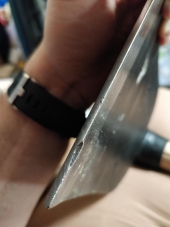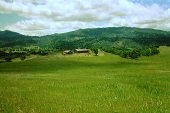



Dado Scooter wrote:Bottom line, if your goal is to grow apple trees, then you might think of going to a good apple growing region, like parts of Washington State and Oregon. I have sisters in both states, and the soil there is good. There are tons of beautiful productive orchards and old orchards that have been pulled out by their huge trunks, out there. There is good community and probably a good market because you see a lot of Californians retiring with good money up there, like my sisters. One of my sisters friends moved from San Jose to Flathead in Idaho.... I just googled Flathead and it seems like it may be a good microclimate for pomes and cherries. And a lot of rich former Californians so I wonder what that is doing for the real estate prices up there.
If toxic chemicals is a concern, I just checked Toxmap, and North Carolina does not seem to be the worst state for toxic dump sites... there are a lot worse. The northeast seems to be the worst for toxicity, and you might have arsenic problems there.
The Rockies and High Plains look to have very little in terms of toxicity. There is also very little rainfall, and very little population. The YouTube Channel "Our Wyoming Life" showed a lone neglected fruit tree that is failing to thrive and needs quite a bit of human watering to keep growing. And these are "grasslands" where they are grazing cattle for market, so just focusing on grasslands is probably not the ideal criteria for what you want to do. You could be driving for miles and miles on grassland and not see a single tree. Ecologically vibrant areas are those that have an interface between forests and meadows that have the highest biodiversity. Personally, I vote for biodiversity!

Michelle Arbol wrote:
Steve Humbolt wrote:
Michelle Arbol wrote:
Steve Humbolt wrote:@Michelle Arbol Thank you for you input. This is very helpful. I spent some time last night looking into Coeur d'alene. I didn't see many homes for sale in the area. What do you think of Western Montana?
@elle sagenev That's a great idea. I'm interested in growing a lot of different trees/plants, but am probably most interested in growing apples. I spent some time looking for how much precipitation it takes to support apple trees but didn't find anything. What trees are you able to grow in your climate, and how much supplemental water do you need? I climates and permaculture designs make a difference, but am trying to gauge what is possible.
Just saw your post. I dont think the @ thing worked to tag me.
Anyway, yeah, im not surprised there isnt much for sale in that area. What sites are you using to find land? Land Watch? Zillow? Not sure, might help to mix it up a bit on that front, use different sites to search. Might get a better picture.
In regards to Western Montana, ive spent some time there and i personally love it. If it wasn't so far from the ocean id plant myself there, hands down. Thats just my personal taste tho. As far as things to be concerned about, well, it gets cold and snowy there. I dont care about that, but a lot of people wouldnt move there because of it. As far as natural disasters, id say fire is the first thing that comes to mind, for sure. Its dry there. But other than fire, im not sure what else would be a huge concern.....I have never lived in Western Montana, so it might be helpful to get better advice from someone who has lived there
hope that helps! Im excited to see where you land!
M
Sorry, I'll try to figure out how to tag.
I've been doing a fair bit of reading and watching videos to try to help figure out where to go. The main videos, articles, and books are:
The article "Finding the Land that's Right for You" (http://tobyhemenway.com/1213-finding-the-land-thats-right-for-you/), video "Permaculture soil basics" (https://www.youtube.com/watch?v=tnOxF75F2b8), "The Permaculture Designers' Manual", and "The Keyline Plan".
From my reading it appears that there are three main types of landscapes: deserts, grasslands, and forests. I'm thinking that grasslands would be the best since they have more organic material than the other landscapes, have a more balanced pH (6-6.3), and I wouldn't have to cut down trees for sunlight to reach a garden. Grasslands occur in North Central Idaho in an area called the Palouse. The largest cities in the grasslands are Moscow and Lewiston. Moscow looks better since it gets 27 inches of rain while Lewiston gets 16. Lewiston looks better than Moscow in terms of hardiness zone (7 vs 5) https://www.extension.uidaho.edu/publishing/pdf/BUL/BUL0857.pdf. Coeur d' Alene still looks temping, although I don't know how much of an issue the soil and trees would be compared to Moscow or Lewiston. Any input is appreciated.
I actually LOLed at this post, because i went to school in the PalouseWashington State, which is in Pullman, WA; directly across the border from Moscow ID. I used to get gas and food in ID since they are both much cheaper there, especially for a broke college student!!
But I digress. I spent 4 years there and can give you an idea of what its like. So the Palouse gets some fairly extreme weather, its hot in the summers (90+ is pretty common) and very cold in the winter, with a lot of snow. I would say that negative 20 or so was as cold as ive seen it there. It gets COLD. In addition, since it is a lot of flat grasslands and a lot of wheat fields, it is fairly windy. As far as natural disasters, other than grass fires i really cant think of much! So on that axis, you might do well. Im not 100% on growing there, i was in college about 10 years ago and was a young dumb person at the time so i didnt take much of an interest in permaculture or agriculture at the time. I do know there are plenty of WSU extension office info, and i bet that can help you out in that regard.
What could be great about the area is that is co-located with one of two Major Universities in WA state, and a major University in Idaho, the Univ of I is in Moscow. Why i say this is a good thing, is that area of the us is very rural, and i get it, i like rural too, but its nice to have some major hubs you can pop in at and know they are close by. These could also help you if you plan on planting an orchard (which is my assumption here) where youd grow fruit and such, you could have more of a population to sell your natural organic produce to
Lewiston/Clarkston areas are huge into agriculture, might be a good area to visit/think about.
If I were you, id def stay on the Idaho side if youre considering that area. Much better overall cost of living and better on taxes, too. You can always cross the boarder if you want to mix it up a bit.
I think thats pretty much it. Let me know if you have any questions

Mike Jay wrote:Not sure if this is in your area of interest but it just popped up: Unique mountain acreage for sale in Idaho with two creeks

Dado Scooter wrote:The extension article you posted protrays a pretty bleak picture of gardening in Idaho. Perhaps you could actually stay for a year to figure out if the climate is right for you. I have never been to Moscow, but I see pictures of equine endurance rides from the area and all I see is a lot of rocks and brush. Also, what is called grasslands may be overgrazed and would require a lot of remediation. When you look at water patterns, you must realize that there are probably very few basins in the area. Anywhere in the Rockies and nearby would be a very harsh environment to establish permaculture grounds, but I guess you are looking for a challenge.
I see a lot of happy homesteaders on YouTube who settled in North Carolina. Lack of water isn't a problem, lush green rolling hills and a longer growing season... and it's not California.
 I'd like to do a fair bit of thinking, and get the input of others so I don't make it any harder than it has to be. I have seen a lot of folks on YouTube with hobby farms in NC as well. I considered NC in the beginning of my search, but it appears that there are a lot of superfund sites that are in danger of spilling their contents when flooding occurs (hurricane season etc).
I'd like to do a fair bit of thinking, and get the input of others so I don't make it any harder than it has to be. I have seen a lot of folks on YouTube with hobby farms in NC as well. I considered NC in the beginning of my search, but it appears that there are a lot of superfund sites that are in danger of spilling their contents when flooding occurs (hurricane season etc).


Michelle Arbol wrote:
Steve Humbolt wrote:@Michelle Arbol Thank you for you input. This is very helpful. I spent some time last night looking into Coeur d'alene. I didn't see many homes for sale in the area. What do you think of Western Montana?
@elle sagenev That's a great idea. I'm interested in growing a lot of different trees/plants, but am probably most interested in growing apples. I spent some time looking for how much precipitation it takes to support apple trees but didn't find anything. What trees are you able to grow in your climate, and how much supplemental water do you need? I climates and permaculture designs make a difference, but am trying to gauge what is possible.
Just saw your post. I dont think the @ thing worked to tag me.
Anyway, yeah, im not surprised there isnt much for sale in that area. What sites are you using to find land? Land Watch? Zillow? Not sure, might help to mix it up a bit on that front, use different sites to search. Might get a better picture.
In regards to Western Montana, ive spent some time there and i personally love it. If it wasn't so far from the ocean id plant myself there, hands down. Thats just my personal taste tho. As far as things to be concerned about, well, it gets cold and snowy there. I dont care about that, but a lot of people wouldnt move there because of it. As far as natural disasters, id say fire is the first thing that comes to mind, for sure. Its dry there. But other than fire, im not sure what else would be a huge concern.....I have never lived in Western Montana, so it might be helpful to get better advice from someone who has lived there
hope that helps! Im excited to see where you land!
M


